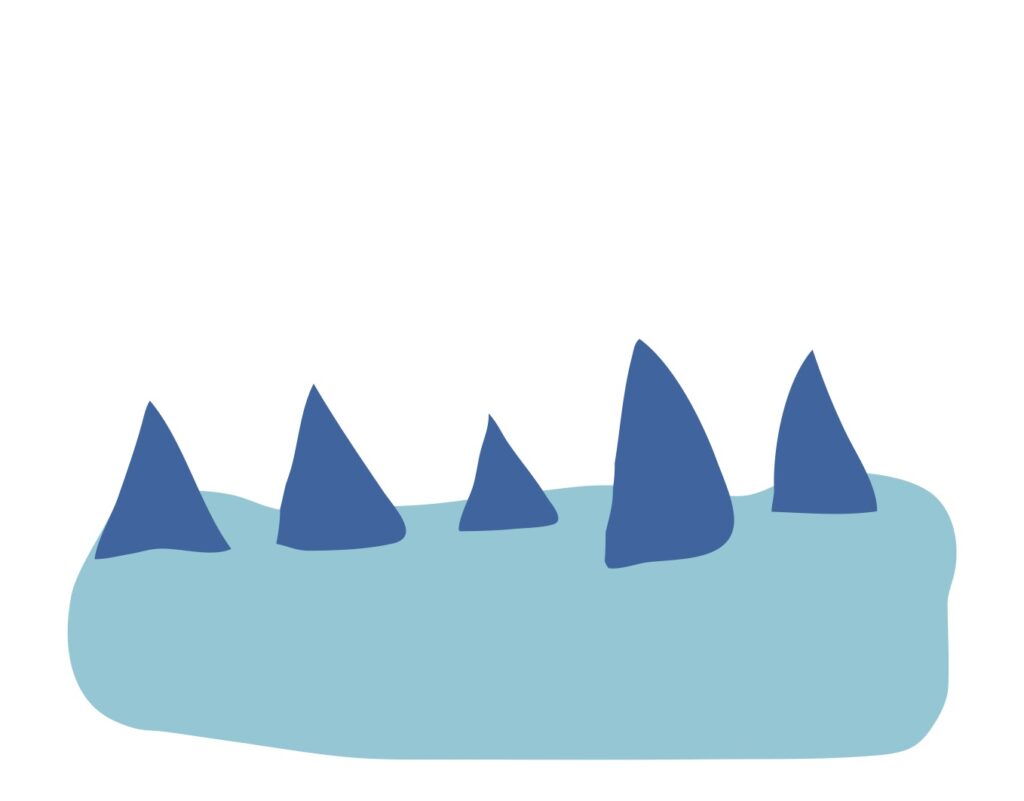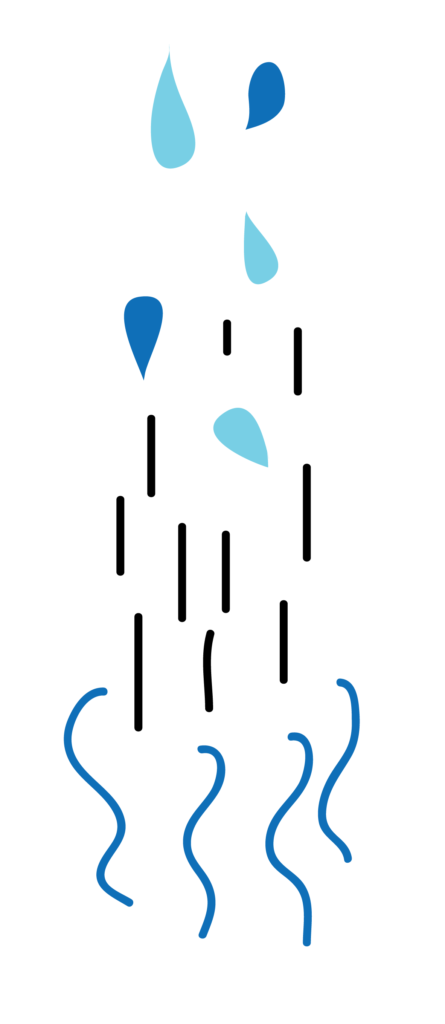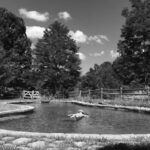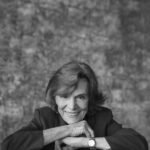
Water is the only element that exists in three different states of matter, and moves fluidly among them: solid, liquid, mist. We humans are usually in one state or another, too, which is not a problem—unless we get stuck.
There’s a Buddhist meditation that invites practitioners to contemplate the presence of the four elements as they exist inside and outside of our bodies. The practice is meant to soften the illusion that our bodies are self-existing entities separate from our environments, and to open us up to the experience of being intimately intertwined with nature itself. Water is the only element that exists in three different states of matter, and moves fluidly among them: solid, liquid, mist. We humans are usually in one state or another, too, which is not a problem—unless we get stuck. This is water’s holy proposition: a lesson in how to shift from one state to another. To be like water is to be responsive to our environment, receptive to our surroundings, adaptable to what is required of us in a given moment—be it structure, fluidity, or spaciousness.
SOLID
Holy water is water that facilitates change.
Water in its solid form is ice, and its sacred property is the fortification of boundaries when the environment gets too cold. Boundaries protect us from harm, both intentional and unintentional, when they are clearly marked. Boundaries work best when they are less like walls and more like gates, or semi-permeable membranes, in which we can choose to close and protect or, when we feel safe, to open up.
“What is your name, and what is your watershed?” It was the first day of a week-long martial arts and leadership training at a ranch near Palo Alto, California. I had not expected our check-in to include a pop quiz. A watershed, our instructor explained, is the name for all of the land whose precipitation drains into a common body of water. It knows no national boundaries, only the peaks between valleys that separate the catchments surrounding a reservoir. We are all always in a watershed, he said, even in the desert. Even in a drought, like now. There’s always a reservoir somewhere that’s waiting patiently for the runoff from the rain to come.
The ranch was settled in the Northern California hills, which from a distance looked like the furry underbellies of great, resting beings covered in golden hair. My partner and I are running late that morning, as usual, so I take the wheel, making up the time on the winding roads that follow the edge of the Tomales Bay. I pride myself on being the better driver, and yet I am annoyed that if I want anything done my way I have to do it myself. I navigate us safely, from the cool valley up into the thirsty hills.

I came to this training to find my power. I’d been feeling a little loose in the middle and did not wish to come apart. When it comes time to practice our new moves with a partner, I do not pair off with my partner, who has accompanied me here. We arrive together, and leave together, and avoid each other in between. Since the rise of #MeToo, I am mad—an icy, punishing rage—at the world. I am on guard for injustice, always. I’ve become tense against my lover’s touch.
The instructor comes by and observes that I have only been working with feet firmly planted on the mat. “You can move,” he reminds me, demonstrating a shift of weight, gliding from one spot to another place without losing his center. “Sure, you can throw a punch, and you can block one. But you can also just step aside.”
I’m humbled by how plainly my body reveals my limitations. Attack and defend have been my primary modes of engagement these days, politically and personally. They are effective, but they are also energetically expensive, and they are shaping my relationships in ways I don’t mean them to. Perhaps I am here, too, to diversify my tactics.
I practice. Softening my knees, I shift my weight as I pivot my feet to turn. I discover I can allow the bowl of my pelvis soften without the contents spilling out. At some point, I think, freezing up must have been my best defense, and now I am learning to glide out of the line of fire.
LIQUID
In hard times, all water is holy water.
In liquid form, water removes obstacles. Even the gentlest trickle can wear down rock over time. Its sacred power is to receive and transmit vibration—energy, intention, sound—over vast spaces and times, from past to future, from here to beyond.
I stood on the corner of Knickerbocker and Flushing Avenues in Bushwick, Brooklyn, in my glimmering red cotillion dress. I could no longer zip the back up all the way, so as I leaned over the bucket of water that I’d placed on a stool, one of the straps, heavy with fabric rosettes, would invariably fall down. A boombox on the sidewalk beside me played love songs I had sung along to a thousand times. “You Really Got a Hold on Me,” by Smokey Robinson. “I Have Nothing (If I Don’t Have You)” by Whitney Houston. “Vision of Love” by Mariah Carey.
This time, I sang them into the bucket of water. Bubbles splashed up onto my face and out onto the sidewalk. I called it performance art. My family called it behaving badly in public.
I had come across Dr. Masuro Emoto’s work on how human consciousness influences the crystalline structure of water. He taped a piece of paper with the word “love” onto bottles, looked at the water they contained under a microscope, and saw them blossom into flower-like crystalline structures, while the word “hate” on other water bottles created sharp, fragmented edges, like knives standing at attention.
Human bodies are about 70 percent water. I wondered what the impact had been of my singing along to popular love songs all my life—songs of lonely, unrequited, desperate love. Grief songs. I didn’t want these words crystallized into my tissues. I was in my late twenties, reeling from the sudden end of a romantic relationship and the equally painful slow fade of my modern dance career. I thought that maybe, singing into this bucket of water, I could let those songs and that grief move through me and back out into the world, and make way for a new kind of love.
In rituals, water removes spiritual obstacles and transforms us in the process. In Christian traditions, believers use holy water to purify the body of its original sin and emerge into a new and sacred life. I was baptized twice. Once, I am told, as a baby, carried by my paternal grandmother to the altar of her Baptist church on what my parents thought was an ordinary Sunday. The second time in a Catholic church, when I was old enough to remember my burgundy velvet dress with lace trim, the shock of the cold water splashing on my forehead and running down my scalp, frankincense mingling with the priest’s echoing songs, the solemn semicircle my mother’s family made around us, watching.
Back home from the martial arts training, I learn that our watershed is the Wissahickon Creek, which flows into the Delaware River, which flows into the Atlantic Ocean. I start visiting the creek, our closest body of water, in something like a ritual. I begin on the walking bridge that connects its shores, standing so that the water flows towards and under me, then cross to the other side and watch it move away. Daily revelations of sexual misconduct in the media, and in my extended spiritual community, are utterly overwhelming my heart. I need to feel this, and I need it to move through me in a way that maintains my capacity to respond. Guatemalan shaman Martín Prechtel teaches that our ability to embrace life, to praise it with our wise action, is directly related to our capacity to grieve. Grieve and praise, grieve and praise, he says.
For praise, I start dancing again, completely non-professionally. An Afro-Cuban dance class in an upstairs room of a West Philly rec center, where women, all ages and races and sizes, gather. After our warm up and opening dances, we go to the sides of the room, digging our circle skirts out of our bags. We take the floor again, long ruffles in hand, to dance the steps of the female deities of the sacred waters. Ochun, the river goddess, is flirtatious, flicking her skirt, stepping on tiptoes with a twist of her waist. She is the embodiment of feminine pleasure. We laugh and call out to each other, YES, BEAUTIFUL!
But it is in the dance for Yemaya, goddess of the ocean, that I find my refuge. The very first time I learn the steps—low to the ground, arms rippling, hips swinging in half moons—something ancient happens. The curve of my belly calls in my ancestral line. This movement, in this gathering of women, is healing. It is healing my ancestors, and all the stories they never told. It is healing my descendents, who I swear will live in a new world, one where they are safe to say yes, and safe to say no, and their bodies are always their own.
That night my partner, now fiancé, comes close to me while I am washing dishes, threading his arm across my waist. For the first time in a long time, I do not flinch. The rhythm of the waves still moves in my body. I show him my new dance, with tears in my eyes.
MIST
In times of grief, salty waters are sacred waters. Whatever’s too heavy for one heart to hold can flow out and be held by the many
Mist is water suspended, particulate, in the air. Mist pervades. It cannot be contained. It suffuses space, mingling with what is present, transforming it into what is possible. The phrase “watershed moment” refers to a turning point, an event that shifts our collective perception such that we are never quite the same. Watersheds are geographic features of the land, but watershed moments take place in time and spread, mist-like, over hearts and minds. The Buddhist texts use a metaphor to describe the heart quality of metta, or the cosmic kindness that is an expression of the awakened heart-mind. In its perfection, a metta heart is said to be like a gentle mist that falls equally on all things. It’s a love so gentle that we don’t even notice that we’re getting wet. It’s a love that is an antidote to fear—not because it destroys the fear, but because it surrounds it with a cushion that takes away the sting.
Healing can be like that sometimes. We go looking for an old wound and realize it’s resolved into a scar, raised but no longer raw. We turn to struggle with an old resentment and find that it’s just a memory now, still present but lacking the charge. That’s one feature of watershed moments—we often know them only in retrospect. In heavy times, love makes water lighter. And these are heavy times. When expansiveness is needed, when only the smallest crack in the system appears, like mist may we rise and rise.
Kate Johnson is a meditation and movement teacher and writer based in Philadelphia. She can be found teaching about mindfulness, embodiment, creativity, and social change at the Institute for Contemporary Art in Philly, the Rubin Museum in NYC, Spirit Rock Meditation Center, the Eileen Fisher Leadership Institute, the Omega Institute, and the Kripalu Center. Currenly, Kate is working on a book about radical friendship as a spiritual superpower, to be published in July 2020 by Shambhala Publications.






